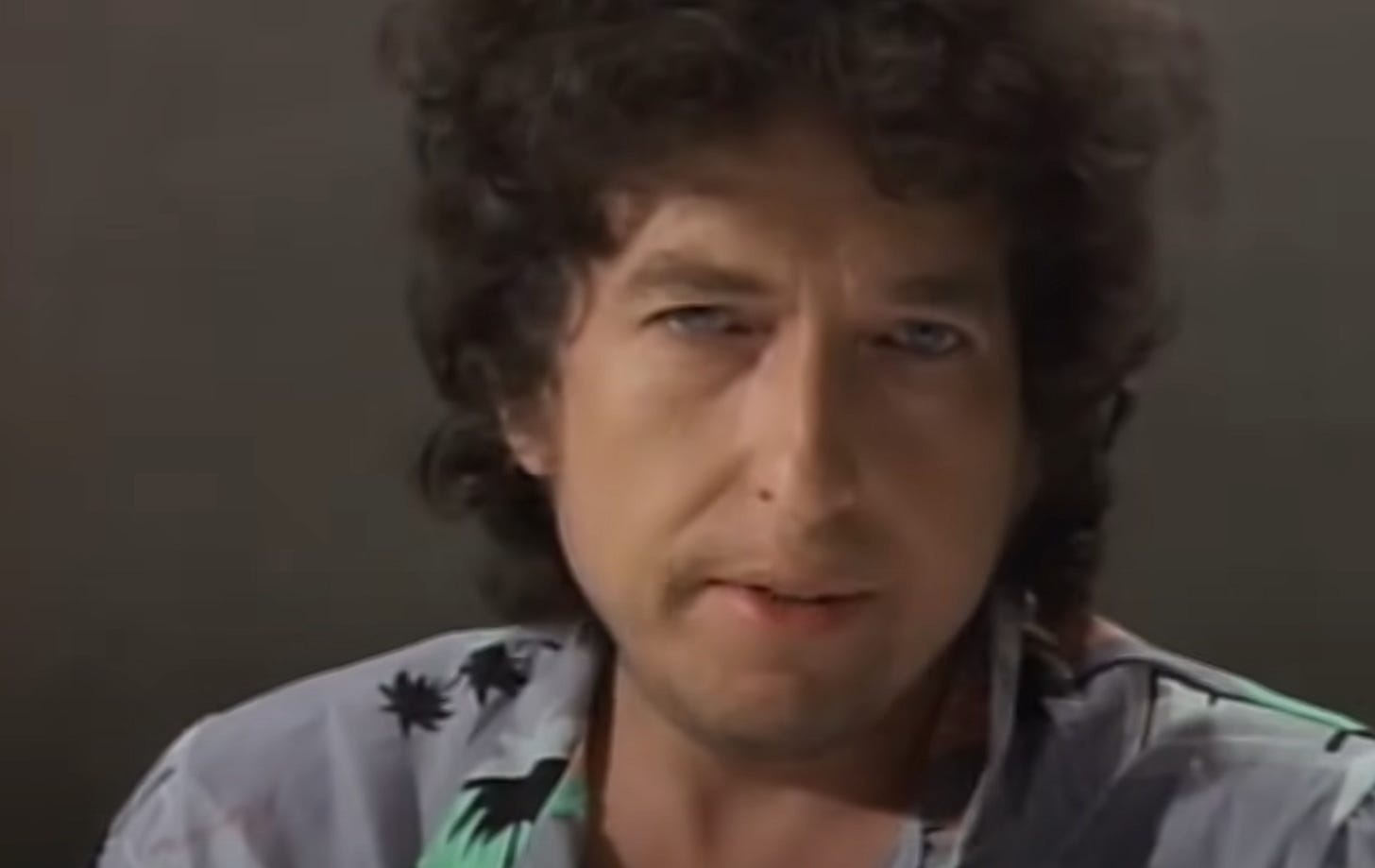How a Tin Pan Alley Songwriter Captured Bob Dylan's Imagination
They shared a sense of open wonder at the creative process.
Bob Dylan completed sessions for Empire Burlesque 40 years ago this month, adding a sly nod to Hoagy Carmichael in “Tight Connection to My Heart (Has Anybody Seen My Love)”: “Well, they’re not showing any lights tonight – and there’s no moon,” he sang. “There’s just a hot-blooded singer, singing ‘Memphis in June.’”
It wasn’t his last connection with this once-famous songwriter from the Tin Pan Alley era.
Of course, Dylan loves old songs – and he loves old movies even more. With Carmichael, he found someone with feet in both worlds: Carmichael sang “Memphis In June” – the song referenced in “Tight Connection” – on screen some 80 years ago in the film Johnny Angel.
Carmichael only had a bit part as surprisingly introspective singing cabbie, but ended up being typecast. “After that,” Carmichael later admitted, “I was mentioned for every picture in which a world-weary character in bad repair sat around and sang or leaned on a piano.”
(That’s precisely what Carmichael did in To Have And Have Not, singing “Hong Kong Blues.” Dylan found lyrical inspiration elsewhere on Empire Burlesque from the same film starring Humphrey Bogart and Lauren Bacall.)
There was more to it, though. Dylan shares a deeper notion about his craft – and, really, the mysteries of creativity – with Carmichael, who once famously said of a song: “Maybe I didn’t write you, but I found you.”
Dylan, in a conversation with Paul Zollo for the book Songwriters on Songwriting, replied: “I know just what he meant.”
They both could sound utterly bewildered by the words tumbling out of their own mouths. “It’s nice to be able to put yourself in an environment where you can completely accept all the unconscious stuff that comes to you from your inner workings of your mind,” Dylan added. “And block yourself off to where you can control it all.”
A rejected early image intended for the American hardback edition of Tarantula, Dylan’s early-’60s collection of poetry, finds him standing in front of a wall pinned with Carmichael’s photo. Dylan made their link more explicit by releasing Americana-fueled updates of Carmichael’s “Skylark” for 2016’s Fallen Angels and “Stardust” on 2017’s Triplicate.
He was hardly alone in returning to “Stardust,” which has been covered hundreds of times by everyone from Frank Sinatra and Ella Fitzgerald to John Coltrane. Ringo Starr brought Carmichael into the world of rock, updating “Stardust” on 1970’s Sentimental Journey with an arrangement by Paul McCartney.
“Like many songwriters, he wasn’t sure where it came from,” Dylan mused on his radio show. “This is what he had to say, the first time he ever heard a recording of ‘Stardust’: ‘And then it happened, that queer sensation that this melody was bigger than me. Maybe I haven’t written it at all. The recollection of how, when and where it all happened became vague.’”
Dylan would admit, in later years, that he reached those places of creative wonder less often – that the songs were harder to come by – even as his friend George Harrison included his own versions of “Baltimore Oriole” and “Hong Kong Blues” on Sometime In England, released just months before Carmichael’s death in 1981.
Dylan wasn’t done with “Memphis In June,” winking at Carmichael again during “Murder Most Foul” from 2020’s Rough and Rowdy Ways. He continues to release sprawling archival box sets and returned to some of his earlier material on 2023’s Shadow Kingdom, but no new songs have followed.
“You have to get power and dominion over the spirits,” Dylan admitted in his memoir, Chronicles: Volume One, echoing Hoagy Carmichael again. “I had it once, and once was enough.”
Amazon best-selling rock band biographer Nick DeRiso’s next book, ‘Forever Young: How the Band and Bob Dylan Made the Only ’60s Music That Still Matters,’ will be released in Spring 2025. www.nickderiso.com.




I’ve been a listener of Robert Allen Zimmerman’s music all my life, and I’m sixty-eight years old now. The first song of his that I consciously remembered was “Lay, Lady, Lay” when I was just a kid in the sixth grade, although his songs from the earlier sixties had wafted through my mind, I’m sure, as I’d lived my first dozen or so years since my birth in 1957, but I didn’t know that they’d been written and sung by a man who called himself “Bob Dylan.” There’s so much of Dylan’s vast catalogue of music like this one that you’ve featured here, "Tight Connection to My Heart (Has Anybody Seen My Love)," that I probably heard forty years ago but don’t remember how or when I’d heard it. I had never seen the MTV video of this mid 1980s song, which is interesting, poetic, and hilarious all at the same time, much like the man himself. I had to look up Hoagy Carmichael, but I know that I’d heard his music growing up too. I just didn’t know who he was or where his music came from, which is the underlying theme of your post, isn’t it, “Where does music come from?” Maybe the question is best left unasked, although I understand the desire to ask it. Maybe the word “magic” is the best and only answer there is. https://youtu.be/H7xDdVc5VE0